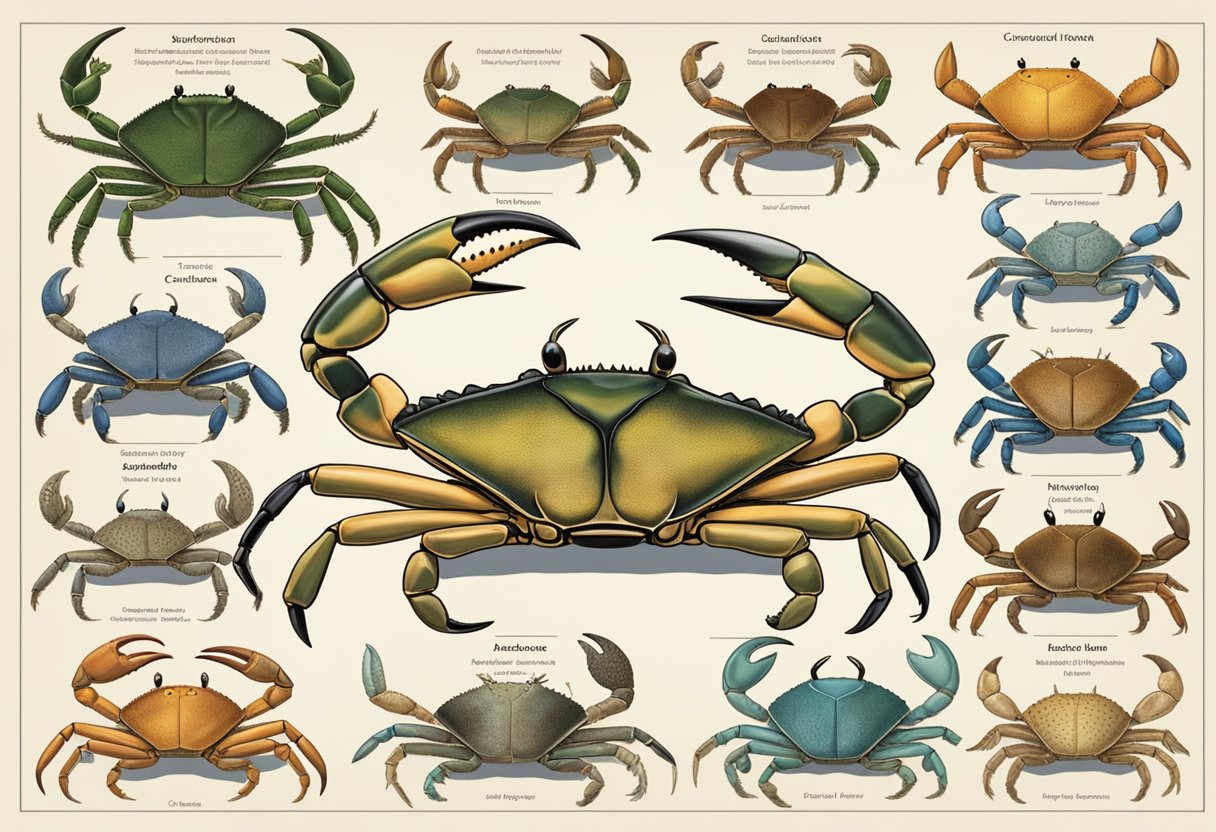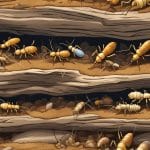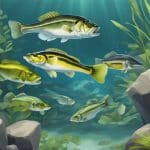Types Of Crabs
Crabs are a type of crustacean that are found all over the world. They are known for their hard exoskeletons, sharp claws, and sideways walking. There are over 4,500 species of crabs, each with unique physical characteristics, habitats, and behaviors.
Crab Taxonomy and Species
Crabs belong to the order Decapoda, which means “ten feet” in Greek. They are closely related to lobsters, shrimp, and crayfish. Crabs are further classified into several families based on their physical characteristics and behavior. Some of the most well-known crab species include the blue crab, king crab, snow crab, and Dungeness crab.
Key Takeaways
- Crabs are a type of crustacean with over 4,500 species.
- They belong to the order Decapoda and are closely related to lobsters, shrimp, and crayfish.
- Some of the most well-known crab species include the blue crab, king crab, snow crab, and Dungeness crab.
Crab Taxonomy and Species

Crabs are a diverse group of decapod crustaceans that belong to the order Brachyura and Anomura. They are found in all of the world’s oceans, as well as in fresh water and on land, particularly in tropical regions. There are over 4,500 types of crabs across the globe, and over 850 different species.
Brachyura
The Brachyura order of crabs is characterized by their short tails and broad, flattened bodies. They include some of the most popular types of crabs, such as blue crabs, snow crabs, and Dungeness crabs. Blue crabs, also known as Callinectes sapidus, are commonly found in the Atlantic Ocean and the Gulf of Mexico. They are known for their delicious meat and are a popular seafood item in the United States. Snow crabs, on the other hand, are a type of Alaskan crab with incredibly long legs. They are often dark brown in color and are often caught for their tasty meat, which is found in their legs and claws. Dungeness crabs are found along the West Coast of North America, from Alaska to California. They have a sweet, delicate flavor and are a popular seafood item in the Pacific Northwest.
Anomura
The Anomura order of crabs is characterized by their long tails and asymmetrical bodies. They include some of the most unique types of crabs, such as king crabs, hermit crabs, coconut crabs, and horseshoe crabs. King crabs, also known as Lithodidae, are a type of deep-sea crab that are known for their large size and delicious meat. They are commonly found in the waters off the coast of Alaska. Hermit crabs, on the other hand, are a type of crab that live in the shells of other animals. They are commonly found on beaches and in tide pools. Coconut crabs are the largest land-dwelling arthropods in the world and are found on islands in the Indian and Pacific Oceans. They are known for their ability to crack open coconuts with their powerful claws. Horseshoe crabs are not true crabs, but are instead more closely related to spiders and scorpions. They are commonly found along the Atlantic coast of North America and are known for their unique appearance and important role in medical research.
Overall, crabs are a fascinating and diverse group of animals that play an important role in both marine and terrestrial ecosystems. From the delicious meat of blue crabs and snow crabs to the unique appearance of horseshoe crabs, there is no shortage of interesting facts and information about these fascinating creatures.
Habitats and Distribution
Crabs are found in a variety of habitats, ranging from saltwater to freshwater, and even on land. Understanding their habitat and distribution is crucial to preserving these remarkable species. The following subsections provide an overview of the habitats and distribution of different types of crabs.
Marine Crabs
Marine crabs are found in oceans, seas, and estuaries. They are adapted to living in saltwater environments and are commonly associated with rocky shores, coral reefs, and sandy bottoms. Some species of marine crabs are found in the Gulf of Mexico, the Atlantic Ocean, and the Pacific Ocean. The North Atlantic is home to several species of crab, including the blue crab, which is a popular seafood in many coastal towns.
Freshwater Crabs
Freshwater crabs are found in rivers, streams, and lakes. They are adapted to living in freshwater environments and are commonly associated with rocks, logs, and vegetation. Freshwater crabs are found in Central America, the Indian Ocean, and Alaska. There are about 850 species of freshwater crabs, and they are an important part of the aquatic ecosystem.
Terrestrial Crabs
Terrestrial crabs are found on land and are commonly associated with tropical regions. They are adapted to living in a variety of habitats, including forests, deserts, and grasslands. Some species of terrestrial crabs are found in the Pacific Ocean, particularly in the Bering Sea. Land crabs are also found in Hawaii and other islands in the Pacific.
In conclusion, crabs are fascinating creatures that inhabit a wide range of habitats across the globe. Understanding their habitat and distribution is crucial to preserving these remarkable species. Marine crabs are found in oceans, seas, and estuaries, freshwater crabs are found in rivers, streams, and lakes, and terrestrial crabs are found on land.
Physical Characteristics
Morphology
Crabs have a unique and recognizable body structure. They have a broad, flattened body shape that allows them to hide in crevices or burrow in sand. Their body is divided into two main parts: the cephalothorax and the abdomen. The cephalothorax is covered by a hard shell called the carapace. It protects the internal organs and provides attachment points for the legs. The abdomen is soft and flexible, and it is used for swimming and reproduction.
Crabs have ten legs, with the first pair modified into large claws or pincers. These claws are used for hunting, defense, and even communication with other crabs. The remaining eight legs are used for walking and swimming. The legs are long and slender, and they are covered with spines and hairs that help the crab grip surfaces.
Adaptations
Crabs have several adaptations that help them survive in their environment. One of the most important adaptations is their exoskeleton. The exoskeleton is made of chitin, a hard and durable material that protects the crab from predators and provides support for the body. The exoskeleton is also waterproof, which helps the crab retain moisture and stay hydrated.
Crabs have a reddish-brown shell that helps them blend in with their surroundings. This coloration is particularly useful for crabs that live in rocky or sandy environments. The shell also provides protection against predators by making the crab harder to see.
In conclusion, crabs have unique and recognizable physical characteristics that help them survive in their environment. Their body structure, legs, claws, pincers, carapace, exoskeleton, abdomen, and reddish-brown shell are all important adaptations that allow them to thrive in a variety of habitats.
Crab Behavior and Life Cycle
Crabs are fascinating creatures that display complex behavior patterns. They have a unique life cycle that unfolds across four main stages: egg development, larval stage, juvenile stage, and adult stage. Each stage presents distinct characteristics and prerequisites for the crab’s survival.
Feeding Habits
Crabs are omnivorous, meaning they eat both plants and animals. They have a varied diet that includes algae, coconuts, nuts, and other marine organisms. Some species of crabs are scavengers, feeding on dead animals and plants. Others are predators, hunting for small fish and other invertebrates.
Mating and Reproduction
Mating in crabs is a complex process that involves the transfer of sperm from the male to the female. Female crabs release their eggs into the water, where male crabs fertilize them. After mating, the female begins to grow thousands of eggs on her underside.
The eggs hatch into larvae, which go through several molts before reaching the juvenile stage. During this stage, crabs are vulnerable to predators and must hide in crevices and under rocks to avoid being eaten. As they grow, they shed their exoskeleton and develop a new, larger one.
In the adult stage, crabs are fully developed and can reproduce. They continue to molt and grow throughout their lives, but at a slower rate than in their juvenile stage. Some species of crabs live for several decades, while others have a shorter lifespan.
In conclusion, crabs are fascinating creatures with a unique life cycle and complex behavior patterns. They play an important role in marine ecosystems and are an important source of food for humans and other animals. Understanding their behavior and life cycle is crucial for their conservation and management.
Commercial and Culinary Importance
Fishery Species
Crabs are commercially important seafood species that are harvested in various parts of the world. The most commonly harvested crab species include king crab, snow crab, and stone crab. These species are highly valued due to their meat, which is known for its sweet and delicate flavor.
King crabs are found in the cold waters of the North Pacific and are known for their large size and meaty claws. Snow crabs, also known as queen crabs, are found in the cold waters of the North Atlantic and are known for their sweet and succulent meat. Stone crabs are found in the warm waters of the Gulf of Mexico and are known for their large claws, which are considered a delicacy.
Cooking and Cuisine
Crab meat is a versatile ingredient that can be used in a variety of dishes. It is commonly used in seafood stews, crab boils, and crab salads. The texture and flavor of crab meat vary depending on the species of crab and the cooking method used. Soft-shell crabs have a tender flesh, while the flesh of hard-shell crabs is firmer.
Crab meat has a sweet and delicate flavor that pairs well with various seasonings and sauces. It is a popular ingredient in many cuisines, including Asian, Mediterranean, and American. Crab cakes, crab soup, and crab dip are some of the most popular crab dishes.
In conclusion, crabs are highly valued for their meat, which is known for its sweet and delicate flavor. They are commercially important seafood species that are harvested in various parts of the world. Crab meat is a versatile ingredient that can be used in a variety of dishes and is a popular ingredient in many cuisines.
Conservation and Threats
Environmental Impact
Crabs play an important role in the ecosystem as they are part of the food chain and are preyed upon by other animals. They also help maintain the balance in the marine and freshwater ecosystems. However, the impact of human activities on the environment has put many crab species at risk. Habitat destruction, pollution, and overfishing are some of the major threats to their survival.
Soft-shell crabs, for example, are a delicacy in many parts of the world, and their demand has led to overfishing. The giant snow crab, which is native to the Arctic, is also at risk due to climate change. The warming of the oceans is causing the sea ice to melt, which is the habitat of these crabs. As a result, their population is declining, and they are facing extinction.
Conservation Efforts
To protect crab species from extinction, conservation efforts are underway. The government has implemented regulations to limit fishing and protect their habitats. Organizations such as the International Union for Conservation of Nature (IUCN) are working to raise awareness about the importance of crab conservation and to implement conservation measures.
The IUCN Red List is a comprehensive database that assesses the conservation status of species worldwide. According to the Red List, some crab species are endangered, while others are vulnerable or critically endangered. The Red List provides information on the distribution, habitat, behavior, and threats to each species, which helps in the development of conservation strategies.
In addition to these efforts, research is being conducted to better understand the biology and behavior of different crab species. This knowledge can be used to develop effective conservation strategies that can help protect these fascinating creatures for future generations.






